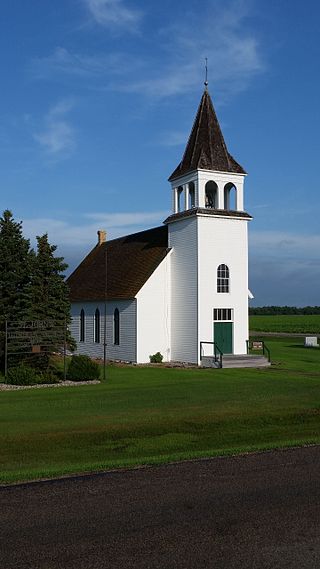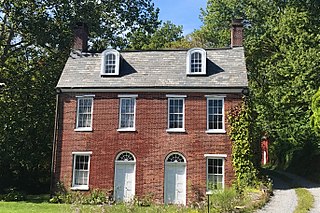
Henry Melchior Muhlenberg, was a German-born Lutheran clergyman and missionary. Born in Einbeck, Muhlenberg immigrated to the Province of Pennsylvania in response to demands from Lutherans for missionary work in the colony. Muhlenberg was integral to the founding of the first Lutheran church body or denomination in North America, and is considered the patriarch of the Lutheran Church in the United States.
The Stillwater Presbyterian Church is a congregation of the Presbyterian Church (USA) located in the village of Stillwater in Stillwater Township, Sussex County, New Jersey, in the United States. It is a member of the Presbytery of the Highlands. Founded in 1769 as a union church shared by members of the Reformed and Lutheran faiths, the parish, now Presbyterian, closed in 2019.
Stillwater Cemetery is a burial ground located in the village of Stillwater in Stillwater Township, Sussex County, New Jersey in the United States. The cemetery has been in use for over 260 years.

Augustus Lutheran Church is a historic church and Lutheran congregation at 717 West Main Street in Trappe, Pennsylvania. Consecrated in 1745, it is the oldest extant Lutheran church building in the United States. It continues to be used by the founding congregation for services on Christmas Eve and during the summer. It was designated a National Historic Landmark in 1967.

The Fairview Schoolhouse is located east of Columbia in the Fairview Cemetery along Dean Road in Knowlton Township in Warren County, New Jersey, United States. It was built in 1835 and documented by the Historic American Buildings Survey (HABS) in 1937. The schoolhouse was added to the National Register of Historic Places on August 12, 1977, for its significance in architecture and education. It is now used by the Fairview Cemetery Association.

The Dundee Township Historic District is a set of sixty-five buildings in Dundee Township, Kane County Illinois. Buildings in the district are found in East Dundee, West Dundee, and Carpentersville. The district represents the development of the upper Fox River Valley from 1870 to the 1920s. Dundee Township became an important industrial area, especially following the construction of the Dundee Brick Company in West Dundee and the Illinois Iron and Bolt Company in Carpentersville. Also included in the district are a variety of Queen Anne, Italianate, and Greek Revival style houses and Gothic Revival churches. The majority of the historic district lies within the boundaries of West Dundee. It was added to the National Register of Historic Places in 1975.

St. John's Lutheran Church of Richland County, was built in 1883 by the faith community originally known as the South Wild Rice Lutheran Congregation, whose constitution was adopted on December 27, 1872. In 1882 the name of the faith community was changed to St. John's as construction of the building began. This wood-frame church still stands on its original "single course, dry-laid, uncut fieldstone foundation," and is located east of the Wild Rice River in the Red River Valley near Galchutt, North Dakota.

Finesville is an unincorporated community and census-designated place (CDP) located within Pohatcong Township in Warren County, in the U.S. state of New Jersey. The CDP was defined as part of the 2010 United States Census. As of the 2010 Census, the CDP's population was 175.
St. James Lutheran Church may refer to

Hebron Church is a mid-19th-century Lutheran church in Intermont, Hampshire County, in the U.S. state of West Virginia. Hebron Church was founded in 1786 by German settlers in the Cacapon River Valley, making it the first Lutheran church west of the Shenandoah Valley. The congregation worshiped in a log church, which initially served both Lutheran and Reformed denominations. Its congregation was originally German-speaking; the church's documents and religious services were in German until 1821, when records and sermons transitioned to English.

The Lamington Historic District is a 84-acre (34 ha) historic district located along Lamington, Black River, Rattlesnake Bridge, and Cowperthwaite Roads in the Lamington section of Bedminster Township in Somerset County, New Jersey. It was added to the National Register of Historic Places on June 21, 1984, for its significance in architecture, exploration/settlement, and religion. The district includes 11 contributing buildings and 3 contributing sites.

St. Michael's Evangelical Lutheran Church is a historic church building in the Mount Airy neighborhood of Philadelphia, just north of the Germantown neighborhood. The congregation was founded sometime before 1728 and three successive church buildings have occupied the same location since that time. The church was closed in 2016.

The John Smith House is a historic building located at 124 Washington Valley Road in the Washington Valley section of Morris Township in Morris County, New Jersey, United States. It was documented by the Historic American Buildings Survey (HABS) in 1937. The house was added to the National Register of Historic Places on January 1, 1976, for its significance in agriculture and architecture. It was designated a contributing property of the Washington Valley Historic District on November 12, 1992.

The Asbury Historic District is a 288-acre (117 ha) historic district encompassing the community of Asbury in Franklin Township of Warren County, New Jersey. It is bounded by County Route 632, County Route 643, Maple Avenue, Kitchen Road, and School Street and extends along the Musconetcong River into Bethlehem Township of Hunterdon County. It was listed on the National Register of Historic Places on March 19, 1993 for its significance in architecture, industry, religion, community development, politics/government, and commerce. The district includes 141 contributing buildings, a contributing structure, two contributing sites, and four contributing objects.

The German Valley Historic District is a 69-acre (28 ha) historic district located in the Long Valley section of Washington Township in Morris County, New Jersey. The district was added to the National Register of Historic Places on July 14, 1983, for its significance in agriculture, education, transportation, industry, and religion.

The Port Colden Historic District is a 91-acre (37 ha) historic district in the Port Colden section of Washington Township in Warren County, New Jersey, United States. It was an important transportation location, being on the Morris Canal. The district was added to the National Register of Historic Places on January 21, 1999 for its significance in transportation, development pattern, commerce, education, and architecture from 1824 to 1924. It includes 59 contributing buildings, 3 contributing sites, and 3 contributing objects.

Bowerstown is an unincorporated community in Washington Township, Warren County, New Jersey near the Morris Canal and the Pohatcong Creek. It was founded in 1829 by Jesse Vanetta and Michael B. Bowers with the building of an iron foundry. The Bowerstown Historic District, encompassing the village, was listed on the state and national registers of historic places in 1996.

Pleasant Valley is an unincorporated community located in Washington Township, Warren County, New Jersey, west of Washington, along the Pohatcong Creek. The hamlet was built around a mill on the creek during the mid-18th century. The Pleasant Valley Historic District, encompassing the village, is listed on the state and national registers of historic places.

The Hixson–Mixsell House, also known as the Springtown Stagecoach Inn, is a historic building at 157 County Route 519 in the village of Springtown, in Pohatcong Township, Warren County, New Jersey. The main block was built c. 1836–1840, with a rear wing built between c. 1790 and 1840. It was added to the National Register of Historic Places on May 12, 2014 for its significance in architecture.

The Kennedy House and Mill are historic buildings located at 306 NJ 173 near Pohatcong Creek in Greenwich Township, Warren County, New Jersey. They were added to the National Register of Historic Places on May 16, 1996 for their significance in architecture, politics/government and industry. The area of Stewartsville, New Jersey is also called Kennedy Mills.

























